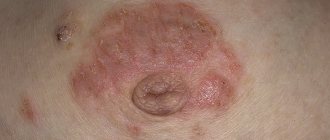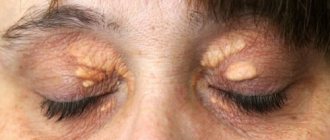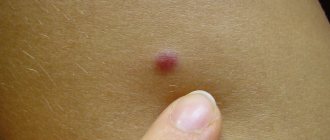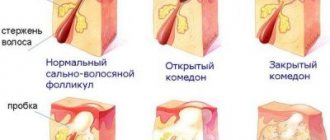Home » Symptoms
03.11.2018 Category: Symptoms
Often, women notice the appearance of spots on the usually dark areola around the nipple. Uncertainty about the origin of spots on the nipples and areola raises health concerns. However, if white spots appear, they rarely indicate the occurrence of malignant neoplasms.
- 1 What are white spots on nipples
- 2 Causes of white spots on the nipples and areola
- 3 Causes of white pimples on nipples
- 4 White spots in early pregnancy
- 5 White spots on nipples during breastfeeding
- 6 Clogging of pores with colostrum
- 7 Infections 7.1 Thrush
- 7.2 Herpes
- 7.3 Subareolar abscess
Causes of white spots on nipples and areola
A small white dot on the nipple or the appearance of white spots on the dark area around the nipple is caused by a disruption in the production of melanin, the substance responsible for cell pigmentation.
The pigment is produced by special cells - melanocytes, which are destroyed during the autoimmune disease vitiligo. In this case, the body mistakes melanocytes for dangerous cells and destroys them.
Vitiligo affects both women and men. The area of distribution of age spots is not limited to the areola of the nipple, but also affects the area around the lips and fingertips. The spots do not look like even circles, but like a concentration of small white specks.
White spots around the nipples may merge into one large white spot or a smaller spot. Whitening of skin areas is not accompanied by a feeling of pain, but makes the appearance of the diseased person specific due to prominent spots (or stripes) of a different color than the rest of the skin.
White spots in early pregnancy
A short time after pregnancy, women notice the appearance of specific pimples and spots around the nipples. The glands located in these tubercles around the nipples respond to changes in hormonal levels and begin to produce a special oily substance, maintaining the softness and elasticity of the skin of the nipples.
Scientists believe that the substance produced by Montgomery's tubercles attracts breastfed babies. They help him find the nipple when the mother begins to feed the baby for the first time. In addition, the secretion of the glands serves as a lubricant and protects the surface of the nipple and the entrance to the milk ducts from germs.
Changes in the size and number of visible Montgomery tubercles on the nipple are considered one of the earliest indicators of pregnancy. Active secretion production makes the tubercle look like a small bump with a white or yellowish top.
Montgomery's tubercles may enlarge and turn white regardless of pregnancy. The reasons for their manifestation may be:
- Hormonal changes before and during menstruation
- Taking oral contraceptives
- Menopause
- Other changes in hormonal profile
The manifestations of Montgomery tubercles near the nipple are painless and do not require treatment when they occur. However, it is not recommended to pierce the surface or squeeze out the contents of the tubercle due to the risk of infection. Painful sensations in the nipples and redness of the Montgomery tubercles indicate infection inside the glands and serve as a reason for contacting a medical facility.
Montgomery tubercles that do not disappear after childbirth and cessation of breastfeeding can be removed surgically. However, after this procedure, mini-scars will remain on the nipples. The following steps will help reduce the size of nipple bumps:
- Applying a warm, damp towel to the areola every day for 20 minutes (the towel should always be warm).
- The use of creams containing celandine, aloe vera, shea butter or cocoa butter.
- Increasing the amount of water consumed and reducing sugar intake.
- Following a diet will help avoid blockage of the Montgomery glands and their subsequent swelling.
How is a diagnosis made for nipple discharge?
At the appointment, the specialist will collect an anamnesis of the disease. He will definitely ask the patient about how long the discharge has bothered her, and whether it is accompanied by painful sensations in the chest. The volume of discharge, its color, the presence of other disturbing symptoms - including fever, visual impairment, etc. – all this is important for making a diagnosis!
After collecting the medical history, the doctor proceeds to examine the patient’s breast. To confirm or refute a preliminary diagnosis, a number of instrumental and laboratory studies may also be required - mammography, blood tests, etc. The examination of the ducts in our private clinic in Ryazan is carried out using ductography.
After making a diagnosis, the mammologist selects a treatment regimen for the detected pathology. This could be antibiotic therapy in case of inflammation, antiviral treatment for patients with HPV, or correction of the patient’s hormonal levels if they are disturbed in her body. If all these treatment methods are ineffective, the doctor prescribes surgery.
Infections
The appearance of pimples is associated with the development of an infection caused by a virus, fungus or bacteria. Although most people are susceptible to infections, breastfeeding women and people with weakened immune systems are at risk.
A white coating on the nipple can also appear on the male chest - the infection can also affect both the skin and the condition of the nipples.
Infections that can cause pimples on the chest:
- Thrush
- Herpes
- Subareolar abscess
Thrush
Thrush is a fungal infection that can develop in the mouth of newborn babies or appear on a woman’s chest as a result of taking antibiotics.
When breastfeeding, the fungus enters the breast tissue through microcracks in the nipple. Symptoms of thrush are the appearance of pimples, accompanied by redness and the development of pain in the nipple-areolar area.
Herpes
The infection is viral in nature. The herpes virus is sexually transmitted, but can be transmitted from mother to child when the woman begins to give birth. The infection affects the infant's oral cavity and is subsequently transmitted to the mother during breastfeeding. Symptoms of herpes include small, fluid-filled blisters on the nipples. Even one punctured blister or burst blister leaves a painful wound, as well as a persistent dark spot on the surface of the areola and nipple.
Subareolar abscess
An abscess is a purulent inflammation of tissue caused by bacterial infection. Most often develops when acute mastitis occurs. Bacteria can also enter the mammary gland from other purulent formations (boils, carbuncles). Such neoplasms are very painful to touch; the skin around the blister is very inflamed, and the body temperature is greatly elevated.
Causes and mechanisms
In normal condition, the skin of the breast is clean, there are no discharges or rashes on it. White nipples can occur during pregnancy, when the gland, under the influence of prolactin, produces colostrum. This is not yet full-fledged milk; at first it is transparent, but soon acquires a white tint and a thick consistency.
Increased lactation after the birth of a child is another situation when the nipples may become covered with milk. But with regular natural feeding of the baby, this does not cause problems. Fordyce granules do not pose any danger - an individual feature associated with the close location of the sebaceous glands to the surface of the skin.
Of course, white spots on the nipples also occur in pathological conditions. Of these, the following should be noted:
- Lactostasis.
- Galactorrhea.
- Candidiasis (thrush).
- Tumors.
We cannot completely exclude the fact that a blister on the nipple may be a manifestation of herpes, and a blister may be an insect bite or an allergic reaction. Each situation requires careful analysis, because only through a full diagnosis can you determine the cause of what is happening and not miss the pathology.
Whitish spots or bumps in the peripapillary area are not uncommon. They can occur for physiological reasons or due to certain diseases.
Painful white spots with lactostasis
Blockage of the milk ducts is accompanied by redness and inflammation of the nipple, as well as an increase in body temperature. This occurs due to stagnation of milk in the mammary gland, manifested by the formation of an inflamed growth with white contents, which begins to hurt more and more.
A woman tries to avoid breastfeeding, but it is not recommended not to breastfeed if lactostasis develops. You can help the ducts free themselves.
To do this you should:
- Apply a warm compress to your breasts before feeding.
- After feeding, apply a cold compress to reduce pain.
- Squeeze a little milk before feeding to soften the nipple.
- During feeding, position the baby so that his lower jaw is near the blocked duct.
If the clogged canal could not be freed from stagnant milk on your own, you should seek help from a specialist. The problem of lactostasis can be solved by puncturing the inflamed, clogged area in the middle of the white spot.
Most types of white plaque around the nipples, as well as the phenomenon of white nipples, occur during lactation and disappear during the implementation of an established feeding pattern. With the adjusted nutritional regimen, the milk ducts are promptly cleared of milk.
Correct positioning of the baby during feeding allows the mother to receive additional stimulation and massage the areola and nipple using the baby's sucking movements.
To prevent the occurrence of lactostasis you should:
- During feeding, make sure that the breast is completely emptied before moving on to the other breast.
- Express excess milk (a special bottle is suitable for storage).
- Monitor the correct position of the baby during feeding.
- Change the baby's position with each new feeding.
- Avoid wearing a tight bra (tightness is indicated by a red stripe on the skin on the side of the chest).
- Position car seat belts, as well as belts of children's portable devices, so that they do not compress the mammary glands of a nursing woman.
It's cancer
Despite the fact that the appearance of white dots, spots and pimples usually has nothing to do with malignant neoplasms, in rare cases oncology causes the nipple to turn white. This occurs when the milk duct is compressed by a developing tumor.
In breast cancer, cancer cells form in the tissues of the milk ducts and areola. Their growth, in addition to the appearance of white, inflamed pimples, is accompanied by the following symptoms:
- Redness, swelling, itching
- Peeling or crusting on the surface of the nipple-areolar complex
- “Retracting” the nipple
- Yellow, orange, or bloody nipple discharge
If these manifestations and spots do not go away within 1-2 weeks, you should consult a doctor - a gynecologist or mammologist for advice. A biopsy prescribed in such cases makes it possible to diagnose breast cancer.
The most common causes of nipple discharge
In many cases, discharge from one or both nipples may be a variation of the norm and be an individual characteristic of the patient. They can only appear when pressed: avoid squeezing the nipples - this in itself can cause discharge. After some time, this symptom will disappear on its own.
However, bloody and black discharge from the nipples may also indicate the presence of some pathology in the woman’s body:
- in patients over 40 years of age, the cause may be so-called ectasia of one or both milk ducts. This pathological condition is an inflammation of the duct followed by its filling with a thick substance, which may have a frightening greenish or blackish tint. The patient has chest pain and is also bothered by copious discharge from the nipples. It is necessary to urgently contact a mammologist for treatment, because in particularly advanced cases, ectasia may provoke the need for surgery;
- In patients with the presence of HPV in the body, intraductal papilloma can provoke the appearance of bloody discharge from the nipples. This is a benign neoplasm, which can also lead to the appearance of a lump in the nipple area - it can be felt by palpation. The patient may also pay attention to dirt that appears on the inside of the bra cup. To make a diagnosis in this case, breast ultrasound is most effective;
- hormonal imbalance caused by excessive production of prolactin by the body can lead to the appearance of yellowish and brownish discharge from the nipples;
- spotting may be a consequence of injury to the mammary gland - for example, a bruise;
- purulent discharge from the chest is a clear symptom of a disease such as mastitis;
- Mastopathy is often accompanied not only by chest pain, but also by discharge from the nipples.
In addition, before the examination, it is impossible to completely exclude the possibility that the patient has a malignant breast tumor. Therefore, if discharge from the nipples appears, you must urgently make an appointment with a mammologist! He will find out the reason for the development of this alarming symptom and, if pathology is present, will prescribe treatment - conservative or surgical.
Depigmentation
The problem of the appearance of white spots around the nipples as a symptom of vitiligo requires separate consideration.
Vitiligo is a disease of autoimmune origin. In such cases, the causes of the disease are unclear. The following actions will help reduce the consequences of the body’s struggle with its own cells:
- Avoiding stress
- Normalization of the gastrointestinal tract and liver
- Regular massage and other relaxing treatments
- Increasing immunity by taking vitamin complexes and immunomodulators











